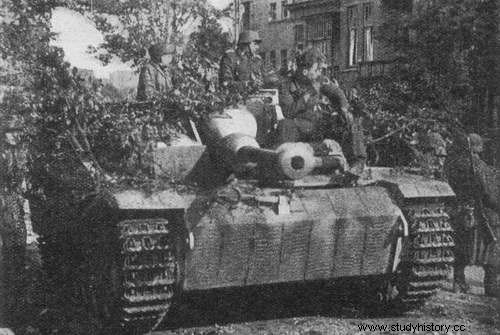
General Willi Bittrich, whom Model sought to reach, was the commander of the 2nd S.S. Armored Corps. Two divisions of this corps. the 9th and 10th, like the S.H.A.E.F. dreaded it and as the Dutch Resistance had reported, had just regrouped and re-equipped northeast and east of Arnhem. The 9th, under the command of Colonel Harzer was quartered near Zutphen, and the 10th, commanded by General Harmel, between Zutphen and Ruurlo. These two divisions (elite, comparable to the "Hermann Goering" or the Alpine), had some of their units in the villages near Arnhem as well as in the suburbs, the surrounding woods, the Dutch barracks to the north from the city and even in open ground, along the road to Nijmegen.
Their tanks, self-propelled guns and armored trucks waited, hidden under green and khaki camouflage netting, under tarpaulins, under trees or in railroad sheds and garages. Although neither of the two divisions had seen their manpower or equipment replenished since the Battle of Normandy, and although most of their armored vehicles were being repaired, these were two elite units of still great combat power with several nearly intact mortar sections. The 9th, in particular, had, against all forecasts, excellent armour.
This was because Colonel Harzer had disobeyed in Berlin when he received the order to withdraw all his vehicles available in Germany. Instead of complying, he had the tracks and guns removed from several of his tanks so that he could say they were unusable.
In addition to these two divisions, were still in the area from Arnhem three quite formidable infantry battalions as well as various scattered elements of Lutfwaffe battalions, including ground personnel, naval personnel from abandoned shore batteries, gunners, many of them from the same background, Dutch S.S., originally formed to guard the Amersfoort concentration camp and placed under the command of the German officer Helle, and finally several anti-aircraft artillery batteries.
The three infantry battalions to be reckoned with were:Colonel Lippert's S.S. NCO Training Battalion and two S.S. Depot Battalions under Majors Kraft and Eberwein. That of Kraft was precisely, this September 17, at the edge of Arnhem.
It was not, however, these units which constituted a serious threat for the British, but well the 8 500 men from General Bittrich's two S.S. armored divisions. He was one of the most popular SS generals in the German army. Tall, stiff, well built, very intelligent, he had, unlike his counterparts, a taste for culture, courteous manners and even a certain sense of humor. He was also very quick-witted, and when Model arrived at his P.C. around 3 p.m. that Sunday, he had already measured the extent of the Allied threat and taken the necessary steps to deal with it.
A combat group of the 9th S.S. panzer division had just started to "crush the enemy troops landed at Oosterbeek". The orders said:“It is important to strike immediately:the main mission being to occupy and keep the bridge in force. »
Units of the 10th S.S. Division were also on the march, but not in the direction of Arnhem. For Bittrich had immediately understood that it was just as important to prevent the junction that the vanguards of the Second Army could not fail to attempt with the paratroopers as to crush the paratroopers themselves. And as the 1st Army might be expected to arrive by the Nijmegen road, it was in that direction that the 10th Division had been ordered to move. "We shall soon be in a position to triumph over the threat north of the Lower Rhine," Bittrich had said confidently, adding:defensively, he is not very formidable in attack. .
The success of Bittrich's plan depended largely on the ability of the defense to oppose the paratroopers as quickly as possible in their march on the city. The enemy's luck would have it that the units that first came into contact with the British were precisely those made up of the young recruits (mostly seventeen to nineteen years old), full of energy, of Major Kraft, who were on the spot between Oosterbeek and Wolfheze.
"There are no two ways to frustrate an airborne landing with inferior forces, said Kraft:you have to go straight into it!" »
Which he did. Having led a company to the airstrip with a mission to buy time, he led his remaining 400 or so men across the Arnhem road to form a line of defense and ordered them to hold there until the end. arrival of the 9th Division, which would extricate them with its armored cars, light tanks and artillery.
The British had not yet landed, he was to declare later with well-justified satisfaction, that we were ready to beat them.
It was 'as soon as they landed that the men of the British Airborne Division experienced their first difficulties. The 21st Autonomous Parachute Company had landed in fairly good conditions and had unrolled its nylon strips on the ground without encountering any opposition. But, if only seven planes of the first wave had been lightly affected by the Flak, several gliders had been lost during the trip, mainly due to broken cables. Now it was precisely there that the majority of the vehicles of the first reconnaissance squadron had been loaded, whose mission was to open the road to the bridges.
